Florida’s common corals
Staghorn Coral – Acropora cervicornis
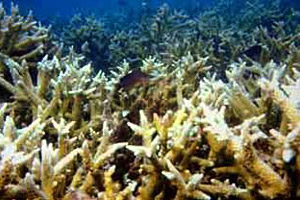
Staghorn coral forms antler-like branches growing in tangled dense thickets. The surface is covered with small, protruding round cups. It is brown to yellow-brown with a pale tip on the end of each branch. The tips are quite delicate and easily broken. Found 10-160 feet (3-49 m) below the surface in protected clear water, colonies cover large areas of the reef. The staghorn coral is listed as a candidate species for the Endangered Species Act of 1973 due to its recent decrease in range.
Elkhorn Coral – Acropora palmata
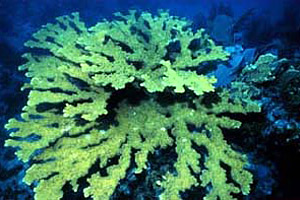
The branches of the elkhorn coral are flat and broad, resembling the antlers of elk or moose. The surface is covered with small, protruding round cups. It is brown or yellow-brown with white corallites along the edges, appearing as a white outline. Colonies cover acres of shallow reef bottom, just below the low tide line.
Lettuce Coral – Agaricia agaricites
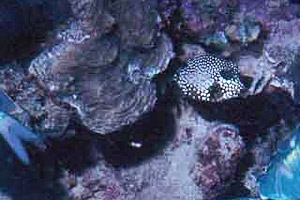
Lettuce coral colonies take on four different forms – hemispherical or encrusting, thick flat leaf-like plates with valleys and ridges, thick leaf-like flat plates without valleys and ridges, and lobes. Cups are located on both the upper and under sides of each colony. All forms are tan to yellow-brown, gray-brown, or brown with purplish tinges. This coral is found in most reef habitats, from mangrove areas and back reefs all the way out to the outer reef and wall.
Grooved Brain Coral – Diploria labrynthiformis
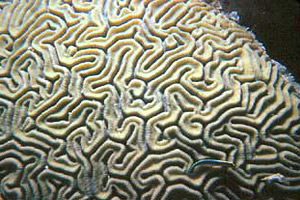
Forming round boulders, colonies have deep interconnected valleys that contain polyps along with broad ridges that have wide, trough-like grooves running down the middle. The grooved brain coral appears tan, yellow-brown, or brownish gray. Commonly inhabiting the seaward slope of the reef, it ranges from 15-50 feet (4.6-15.2 m) in depth.
Common Brain Coral – Diploria strigosa
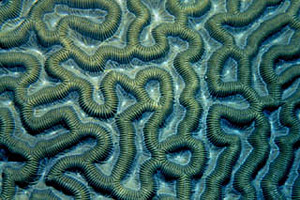
Colonies form smooth plates or hemispherical domes at depths ranging from 3-130 feet (0.9-39.7 m) The corallites are arranged in long valleys along with ridges having no top groove. This brain coral appears green to brown or yellow brown in color with valleys often of a lighter color.
Boulder Star Coral – Monstastrea annularis
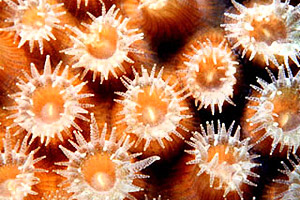
Boulder star corals grow in clusters of thick columns or large boulders up to 5 feet (1.5 m) in diameter. Living polyps are restricted to the upper portions of the column. The lower portions are usually bio-eroded and colonized by algae. This coral commonly occurs at depths between 20-75 feet (6.1-22.9 m), although they can survive to depths of 160 feet (48.8 m).
Great Star Coral – Montastraea cavernosa
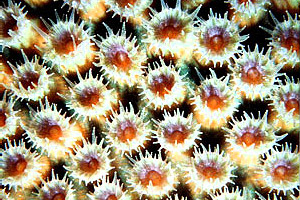
Great star coral colonies form massive boulders and domes over 5 feet (1.5 m) in diameter in waters of shallow and moderate depths. In deeper waters, this coral has been observed growing as a plate formation. It is found throughout most reef environments, and is the predominant coral at depths of 40-100 feet (12.2-30.5 m). Large polyps cover the surface of each colony, giving it a green, brown or yellow-brown coloration.
Ivory Bush Coral – Oculina diffusa
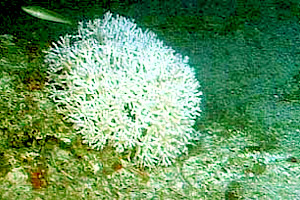
Dense branches growing in clumps are characteristic of the diffuse ivory bush coral. The short branches are crooked with raised corallites. It appears yellow-brown, commonly encrusted with other organisms resulting in a varied color appearance. The diffuse ivory bush coral thrives in areas of high sedimentation including hardbottoms, lagoons, and back reef areas to depths of 40 feet (12.2 m).
Mustard Hill Coral – Porites asteroides
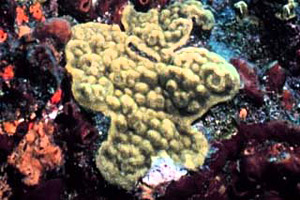
Forming rounded heads and domes in deeper waters, this coral occurs only in the encrusting form in shallow high water energy environments. The bright yellow or yellow-green surface appears lumpy and porous due to the closely set corallites. The polyps give the colony a soft, fuzzy appearance when extended. The mustard hill coral is common throughout all areas of the reef to depths of 160 feet (48.8 m).
Clubbed Finger Coral – Porites porites
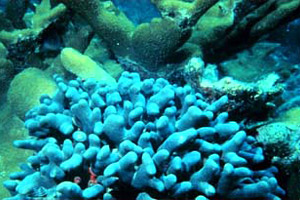
Inhabiting most areas of the reef to depths of 160 feet (48.8 m), the finger coral has clumps of smooth, short branches with swollen ends. The clubbed finger coral is beige, yellow-brown, brown, or gray with a purple tint in coloration. It is commonly found at the back reef, although much larger specimens may be found on the fore reef zone.
Massive Starlet Coral – Siderastrea siderea
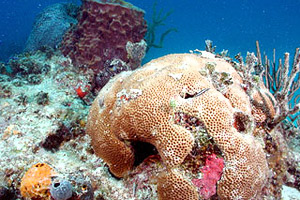
Forming rounded heads or boulders up to 4 feet (1.2 m) or more in diameter, the surface of the massive starlet coral is covered with round, pitted corallites. These light gray to golden brown uniformly colored corals inhabit shallow to moderate reefs at depths ranging from 25-45 feet (7.6-13.7 m). The massive starlet coral prefers clear water and lives in protected areas of shallow reefs.